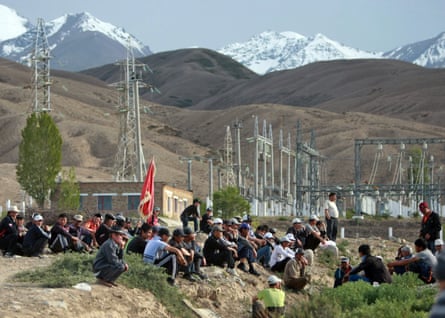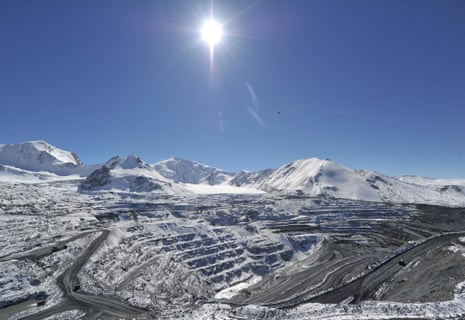The remote Issyk Kul province in eastern Kyrgyzstan, on the border with China, is home to some of the most stunning vistas of the rugged Tian Shan mountain range that cuts through much of Central Asia. Mountain goats and endangered snow leopards roam the rocky slopes, while rare species of dandelion and wild tulip bloom in alpine meadows.
But far from being a serene backdrop to peaceful village life, the Tian Shan (Mandarin for “celestial mountains”) in this part of Kyrgyzstan are at the centre of one of the region’s most ambitious and controversial mining projects and a long-running and increasingly tense conflict with communities nearby.
High up in the mountains, the Canadian company Centerra Gold is digging for gold at Kumtor, the biggest open-pit mine in Central Asia. It’s a process that requires controversial “ice mining” to dig into glaciers and release the precious metal in the rock below.
Fears about the environmental impact of the mine and anger over who is benefiting have sparked protests over the past five years targeting Kumtor. But opposing the mine is dangerous, according to local activists who say they have been subject to threats, harassment and violence.
“I was beaten to make sure I would keep quiet,” says Rustam Atabayev*, a young man who recently moved his family to a different town – further away from the mine – in fear for their safety. Atabayev says he was lured into a stranger’s home last year and badly beaten by other villagers for joining in protests against Kumtor.
“They demanded that I stop supporting anti-mining protests and activism,” said Atabayev, who says controversy around the mine has pitted neighbour against neighbour. His assailants videotaped his beating on their mobile phones, he added. “They beat me for hours and I was at home for days recovering.”
Kyrgyzstan, the only parliamentary democracy in Central Asia, is often seen as more open and democratic than its neighbours. But the country’s human rights record remains poor with frequent and chilling reports of torture and ill-treatment of prisoners. In December 2015, a Human Rights Watch researcher was refused entry and told that she was “banned” from the country, prompting the organisation to warn that the state’s “quest to prevent human rights scrutiny sends a dangerous signal about its intentions”.
About 350km south-east of the capital Bishkek, the Kumtor gold mine is one of the main drivers of Kyrgyzstan’s economy. As the country’s largest foreign investment and biggest private employer, the mine accounted for (pdf) as much as 23% of Kyrgyzstan’s total industrial output and 7.4% of GDP in 2014.
It also has powerful partners including the public, London-based European Bank for Reconstruction and Development (EBRD) – which has provided Centerra Gold with millions of dollars in financing – and the Kyrgyzstan government, which owns a third of Centerra’s shares through a state company called Kyrgyzaltyn.
Atabayev says the gold mine has divided villagers living near the project, with some benefiting from it more than others. “There are certainly good things at Kumtor such as good salaries [for those who work there],” he says. “But there are only 3,000 people working at the gold mine while we have a population of [nearly] 6 million in Kyrgyzstan.”
In Issyk Kul, tensions flared in 2013 into weeks of unrest starting with a blockade of the road leading to the mine and culminating in the occupation of Kumtor’s power station, temporarily cutting electricity to the project. Clashes with police and security forces left dozens wounded and prompted a government “state of emergency” and the imposition of a curfew in the area for 10 days.

Following the protests, dozens of villagers were arrested. Five are understood to have been imprisoned, including two men convicted of trying to extort millions of dollars from company officials (charges they denied). Another five villagers are understood to be still on trial, charged with disturbing the peace.
Marat Karabayev*, 31, says more protests are “certainly going to take place”.
“There are too many problems in the villages. Social, economic and environmental issues combined,” says Karabayev, whose sibling is among the imprisoned protesters. “The government used force against us. Since then, we are going into a third year and things are getting worse.”
Kumtor’s remote location – combined with fear of retaliation for opposing the mine – makes the human rights situation around it hard to monitor.
Sukhgerel Dugersuren, executive director of Oyu Tolgoi Watch, a Mongolian NGO, says she was prevented from talking to local communities when she tried to visit the area in October.
“We were forced to leave Issyk Kul by state security, which had come to our hotel in double the number of our team and left us alone only after we promised to leave the town immediately,” says Dugersuren, who was travelling with the European environmental group Bankwatch and human rights activists from the Irish NGO Front Line Defenders.
“We also have activists [in Mongolia] jailed or charged with trumped up cases … or just beaten, harassed by local forces,” she says.
Atabayev said his main concern is how the Kumtor mine is affecting already fragile glaciers on the Tian Shan mountains.
The mine’s tailings pond sits 5km below Petrov Lake, which is fed by glaciers that melt naturally as the seasons change. But mining upstream, combined with the effects of global warming, could tip the balance and cause the already rapidly expanding lake to flood.
If this happens, Atabayev fears it could wipe out at least part of the tailings pond, spilling cyanide and other chemicals into the Kumtor river, which flows into a water system that millions of people depend on for irrigation, fishing and household use.
“As a large opencast mine, it is inevitable Kumtor has impacts on the local natural environment,” the company acknowledges on its website. It says it is “committed to understanding our impacts” and that “in response to concerns raised by some stakeholders”, it no longer deposits waste rock directly on glaciers.
But controversial practices like ice mining are critical to its operations. “Should Kumtor be prevented from continuing its practice of mining ice, the entire [project] … would be at risk, leading to an early closure of the operation,” Centerra Gold warned in a 2015 technical report (pdf).

John Pearson, vice-president of investor relations at Centerra Gold, says the company is carefully monitoring Petrov Lake to “mitigate the risk of an outburst” and that it has contributed 1% of its gross revenue to a regional development fund since 2009 – making a total of $46m (£31m) so far.
The company, Pearson adds, has “a number of programmes aimed at the integrated development of the Issyk Kul province … [to] reduce the impact when the mine closes on the local communities”.
“Kumtor and Centerra do not condone any sort of violence or threats and/or harassment to groups or individuals. People have the right to organise and participate in peaceful legal protests,” he says.
The EBRD said its staff visit Kumtor “at least annually” but that “given the remote location of the mine, it is not always possible to visit local communities”.
The development bank said it had reviewed reports from “independent environmental and social consultants [who] have also audited the mine operation … on behalf of various bodies, including the mine itself, the Bank and the Kyrgyz government”. It said “social and community issues have featured in some of these studies … [but] no major issues have been identified”.
Kyrgyzaltyn did not respond to requests for comment.
Based on Centerra’s estimates, operations at Kumtor will cease in 2026 – fewer than 10 years from now. It says it is working on a plan to close the mine safely, but Atabayev is fearful that the area will be left with nothing but environmental catastrophe when the company pulls out.
“Once they extract all the gold at Kumtor, they have to close the project … This is what worries me,” he says. “What’s going to happen after? What will our descendants have?”
* Names have been changed to protect identities

Comments (…)
Sign in or create your Guardian account to join the discussion